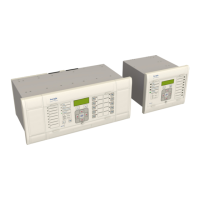When the element is selected as directional (directional devices only), a VTS blocking option is available. When the
r
elevant bit is set to 1, operation of the Voltage Transformer Supervision (VTS) will block the stage. When set to 0,
the stage will revert to non-directional.
5.4 APPLICATION NOTES
5.4.1 SETTING GUIDELINES (GENERAL)
Since the negative phase sequence overcurrent protection does not respond to balanced-load or three-phase
faults, negativ
e sequence overcurrent elements may provide the desired overcurrent protection. This is particularly
applicable to Δ−Y grounded transformers where only 58% of the secondary per unit phase-to-ground fault current
appears in any one primary phase conductor. Backup protection can be particularly difficult when the Y is
impedance-grounded.
5.4.2 SETTING GUIDELINES (CURRENT THRESHOLD)
A negative phase sequence element can be connected in the primary supply to the transformer and set as
sensitiv
ely as required to protect for secondary phase-to-earth or phase-to-phase faults. This function will also
provide better protection than the phase overcurrent function for internal transformer faults. The NPS overcurrent
protection should be set to coordinate with the low-side phase and earth elements for phase-to-earth and phase-
to-phase faults.
The current pick-up threshold must be set higher than the negative phase sequence current due to the maximum
normal load imbalance. This can be set practically at the commissioning stage, making use of the measurement
function to display the standing negative phase sequence current. The setting should be at least 20% above this
figure.
Where the negative phase sequence element needs to operate for specific uncleared asymmetric faults, a precise
threshold setting would have to be based on an individual fault analysis for that particular system due to the
complexities involved. However, to ensure operation of the protection, the current pick-up setting must be set
approximately 20% below the lowest calculated negative phase sequence fault current contribution to a specific
remote fault condition.
5.4.3 SETTING GUIDELINES (TIME DELAY)
Correct setting of the time delay for this function is vital. You should also be very aware that this element is applied
primarily to pr
ovide back-up protection to other protection devices or to provide an alarm. It would therefore
normally have a long time delay.
The time delay set must be greater than the operating time of any other protection device (at minimum fault level)
that may respond to unbalanced faults such as phase overcurrent elements and earth fault elements.
5.4.4 SETTING GUIDELINES (DIRECTIONAL ELEMENT)
Where negative phase sequence current may flow in either direction through an IED location, such as parallel lines
or ring main systems, dir
ectional control of the element should be employed (VT models only).
Directionality is achieved by comparing the angle between the negative phase sequence voltage and the negative
phase sequence current and the element may be selected to operate in either the forward or reverse direction. A
suitable relay characteristic angle setting (I2> Char Angle) is chosen to provide optimum performance. This setting
should be set equal to the phase angle of the negative sequence current with respect to the inverted negative
sequence voltage (–V2), in order to be at the centre of the directional characteristic.
The angle that occurs between V2 and I2 under fault conditions is directly dependent on the negative sequence
source impedance of the system. However, typical settings for the element are as follows:
● For a transmission system the relay characteristic angle (RCA) should be set equal to –60°
● For a distribution system the relay characteristic angle (RCA) should be set equal to –45°
Chapter 9 - Current Protection Functions P64x
214 P64x-TM-EN-1.3

